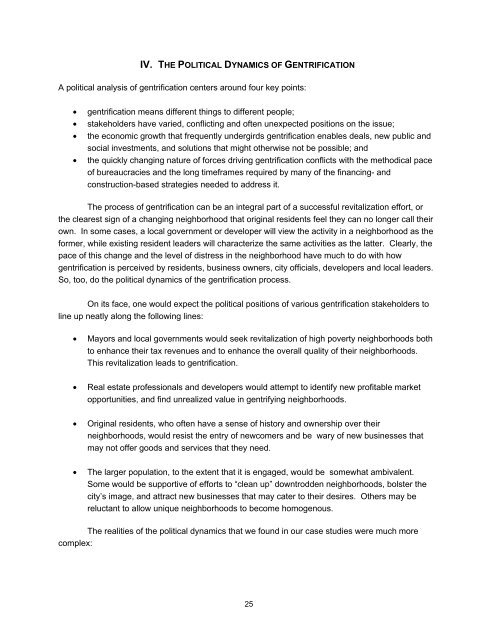gentrification
gentrification
gentrification
Create successful ePaper yourself
Turn your PDF publications into a flip-book with our unique Google optimized e-Paper software.
IV. THE POLITICAL DYNAMICS OF GENTRIFICATIONA political analysis of <strong>gentrification</strong> centers around four key points:• <strong>gentrification</strong> means different things to different people;• stakeholders have varied, conflicting and often unexpected positions on the issue;• the economic growth that frequently undergirds <strong>gentrification</strong> enables deals, new public andsocial investments, and solutions that might otherwise not be possible; and• the quickly changing nature of forces driving <strong>gentrification</strong> conflicts with the methodical paceof bureaucracies and the long timeframes required by many of the financing- andconstruction-based strategies needed to address it.The process of <strong>gentrification</strong> can be an integral part of a successful revitalization effort, orthe clearest sign of a changing neighborhood that original residents feel they can no longer call theirown. In some cases, a local government or developer will view the activity in a neighborhood as theformer, while existing resident leaders will characterize the same activities as the latter. Clearly, thepace of this change and the level of distress in the neighborhood have much to do with how<strong>gentrification</strong> is perceived by residents, business owners, city officials, developers and local leaders.So, too, do the political dynamics of the <strong>gentrification</strong> process.On its face, one would expect the political positions of various <strong>gentrification</strong> stakeholders toline up neatly along the following lines:• Mayors and local governments would seek revitalization of high poverty neighborhoods bothto enhance their tax revenues and to enhance the overall quality of their neighborhoods.This revitalization leads to <strong>gentrification</strong>.• Real estate professionals and developers would attempt to identify new profitable marketopportunities, and find unrealized value in gentrifying neighborhoods.• Original residents, who often have a sense of history and ownership over theirneighborhoods, would resist the entry of newcomers and be wary of new businesses thatmay not offer goods and services that they need.• The larger population, to the extent that it is engaged, would be somewhat ambivalent.Some would be supportive of efforts to “clean up” downtrodden neighborhoods, bolster thecity’s image, and attract new businesses that may cater to their desires. Others may bereluctant to allow unique neighborhoods to become homogenous.The realities of the political dynamics that we found in our case studies were much morecomplex:25


